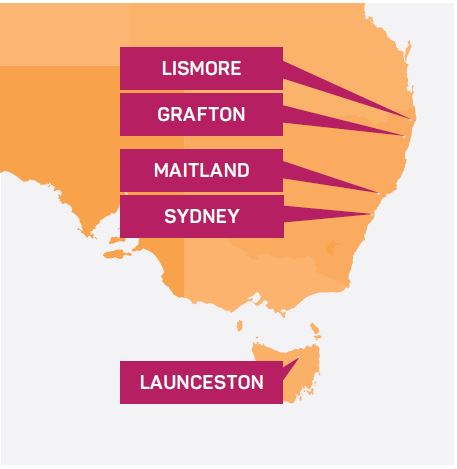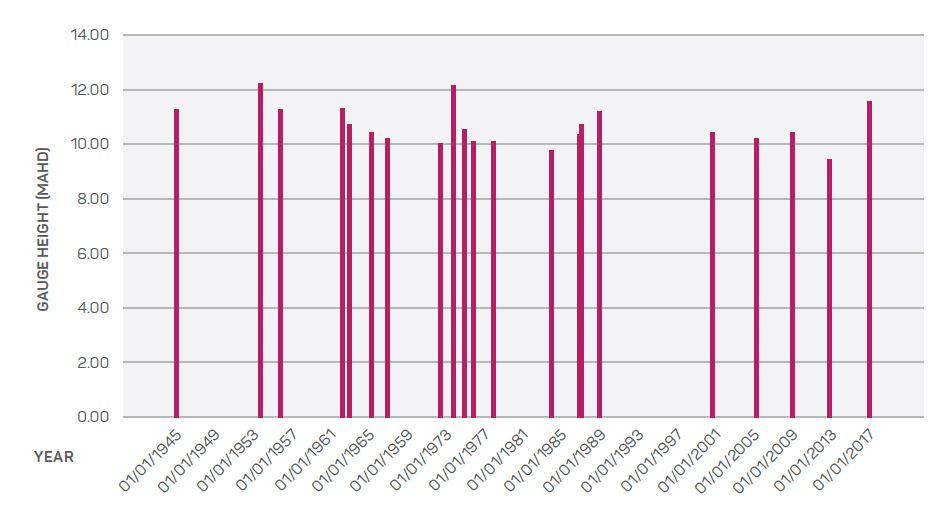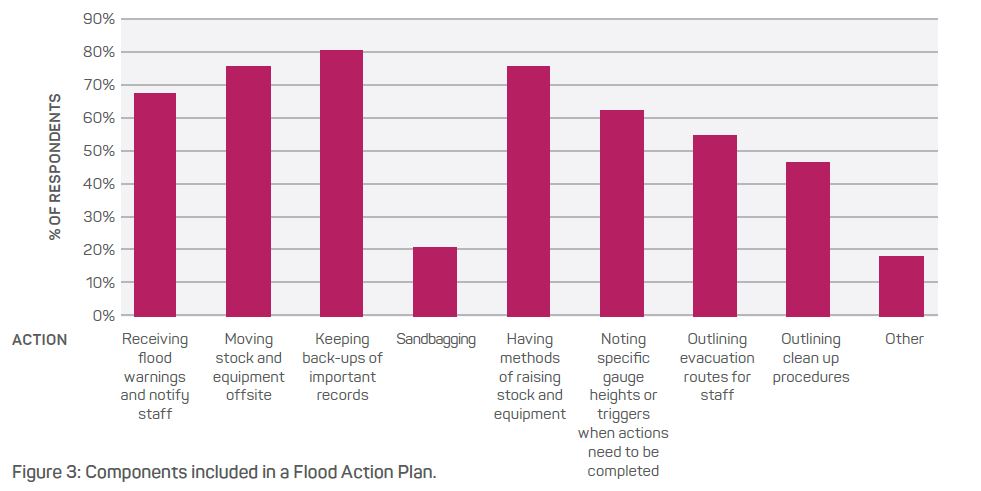Abstract
Flood levees are a commonly used method of flood protection. Previous research has proposed the concept of the ‘levee paradox’ to describe the situation whereby the construction of levees leads to a lowered community awareness of the risks of flooding and increased development in the ‘protected’ area. The consequences of this are the risks of larger losses in less frequent but deeper floods when levees overtop or fail. This paper uses the recent history of flooding and levee construction to investigate the ‘levee paradox’ through a study of flood preparedness and floodplain development in Lismore, NSW.
Introduction
Flooding is Australia’s second most deadly natural hazard after extreme heat and excluding disease epidemics (Coateset al. 2014). Floods are also destructive to the built environment and have caused approximately $5.2 billion in insurance losses between 1967 and 2013 (Productivity Commission 2014). Engineering works in the form of flood levees (also known as stopbanks and dykes) are commonly used to reduce the frequency of flood damage. Smith (1998) suggested their popularity as a mitigation measure stems from their highly visible appearance, the perception that their protection is effective and that they are largely funded by governments rather than private individuals.
Levees are built to reduce flood damage and increase the time available for communities to evacuate. Unless constructed to the height of the Probable Maximum Flood (PMF), a flood with an Annual Return Interval (ARI) of around 10,000 years, levees will ultimately be overtopped. Levees may also fail by other means, such as seepage and piping. It is impracticable to construct levees to protect against all magnitudes of flooding.
Previous research suggested that following the construction of a flood levee, a community may incorrectly believe itself to be ‘flood free’ and, because of the subsequent reduction in flood frequency, awareness of the potential damage from flooding may diminish. This situation is made worse as new residents move into the area without having experienced a flood before. Collectively, these factors can lead to increased development on the floodplain behind the levee and reduced community preparedness; ultimately amplifying ood damages when they inevitably occur (Keys 2016; Smith 1998, 2002, 2003; Tobin 1995; Maddocks et al. 2007). This effect has been referred to as the ‘levee paradox’ (Smith 2002, 2003), the ‘levee effect’ (Tobin 1995) and the ‘safe development paradox’ (Burby 2006). Moreover, the ‘levee paradox’ may lead to a cycle of levee raising where communities demand higher levees be built after each levee failure to maintain an illusion of complete flood protection (Keys 2016, Wenger 2015, Smith 1998).
In the US, Baldassarre and colleagues (2013) outlined how levees have been used to transform previously frequently flooded rural areas or wetlands into rarely flooded urbanised areas, thus setting up the potential for catastrophic flood events. Burby (2006) states that the damage resulting from Hurricane Katrina had been amplified by increased development of flood-prone lands behind levees.
Direct flood experience has been identified as a key determinant of increased community risk perception (Wachinger et al. 2013). It is also an important factor in influencing preparedness behaviours (Bubeck et al. 2012, Molino & Gissing 2005) and for reducing flood damage (Smith 1998). Smith (1998) suggested that smaller, more frequent flooding is important to maintain a community’s skills in managing the effects of flooding. This implies that levee construction may have the effect of reducing such skills.
To examine the ‘levee paradox’ notion, a study of flood preparedness and floodplain development in Lismore, NSW was undertaken. The study took advantage of recent flood history and levee construction. This paper provides an overview of the study and proposes suggestions for further research.

Figure 1: Location of Lismore in NSW
Flooding in Lismore, NSW
The community is known for its ‘flood culture’. Previous studies have found that the community is well prepared for flooding (Gissing 2003, Smith 1981). Following flooding in 1974, Smith (1981) found that previous flood experience and flood warnings had resulted in relatively low damage. Some 26 per cent of businesses had been previously flooded more than five times (Smith et al. 1979).
After the CBD was flooded in 2001, it was again identified that businesses had avoided major losses as a consequence of preparedness measures undertaken and activated once flood warnings were received. These included mitigation measures such as raising shop fittings and equipment, use of mezzanine floors and implementing a Flood Action Plan (Gissing & Leigh 2001).
In 2005, a levee was constructed at the cost of $21 million to protect the CBD from flooding up to the 1-in-10-year ARI event (Moorhouse et al. 2014). At the time of design, it was also intended to provide an additional three to four hours for businesses to evacuate (Lismore City Council 2002).
In 2014, Lismore City Council adopted an updated Floodplain Risk Management Plan that provided an overview of measures to manage the residual flood risk. These measures include land-use planning controls, flood warning systems, emergency management and community education and awareness activities (Lismore City Council 2014).
The CBD levee overtopped for the first time in March 2017, flooding the CBD. This was almost 12 years since it was constructed and 16 years since the Lismore CBD was last flooded from the Wilsons River. As of August 2017, it was reported that one in six businesses had not reopened (Murphy 2017).
Community education and awareness efforts have involved collaboration between the NSW State Emergency Service (SES) and Lismore City Council to inform business owners using brochures, signs, websites and public meetings. Messages encouraged businesses to develop and maintain a Flood Action Plan. Information provided addressed the flood threat, the efficacy of preparedness measures and how to implement them.

Figure 2: Occurrence of major floods recorded at the Lismore Rowing Club gauge. Source: Bureau of Meteorology
Methodology
Preparedness survey of businesses
A telephone survey of business owners in the Lismore CBD was undertaken in November 2016 and February 2017. It used a structured questionnaire containing open and closed questions to draw out information about levels of flood preparedness and perceptions of flood risk. Respondents were targeted based on the location of their business operations within the flood-prone area of the CBD. In total, 50 responses, out of an estimated 400 flood-prone businesses, were collected from different business categories. Survey results were compared with a previous study of flood preparedness in Lismore (Gissing 2003) to determine if any changes in flood preparedness had occurred since the flood levee was built in 2005. Following flooding in March 2017, a question regarding perceptions of flood preparedness was included in a wider community survey with 15 Lismore businesses responding (Haynes et al. 2017).
The survey and methodology were approved by the Macquarie University Ethics Committee.
Assessment of floodplain development
For an assessment of the extent of development in areas protected by the levee, various planning documents including the Lismore City Council Floodplain Risk Management Plan and Local Environmental Plans were reviewed. Interviews were conducted with a key government officer and a local flood consultant about development controls in the Lismore CBD.
Results
Impacts on business preparedness
Over 70 per cent of businesses surveyed had operated in the Lismore CBD for more than 10 years with 56 per cent of respondents reporting they had previously experienced flooding. Flooding of the Wilson River that they recalled were those in 1954, 1974, 1984, 1987, 1989 and 2001.
Prior to the April 2017 flood, almost all respondents (95 per cent) were aware of the Lismore CBD levee. Respondent perceptions regarding how often they would expect to be flooded in the future varied from never to once every year. Forty-three per cent believed correctly that they would be flooded on average once every 10 years and 22 per cent believed once every five years. Thirty-two per cent overestimated the protection offered by the levee believing they would be flooded less than once in every 10 years on average (note: the overtopping ARI of the levee is 10 years).
Following the April 2017 flood, the additional survey of 15 businesses found that 14 of the 15 believed that the community was less prepared since the construction of the levee. Some of the businesses surveyed prior to the flooding acknowledged they had been lucky not to have experienced flooding and acknowledged the value of SES and council efforts to educate communities:
"We’re massively lucky that we haven’t had any big floods for so long, new business owners don’t really know what to expect.
I went to an SES meeting for business owners about a year ago about floods and learnt a lot, I think it should be mandatory to go to things like that and listen to what people who have had to deal with full-on floods have to say."
Some held unrealistic beliefs about the protection offered by the levee:
"A flood would now have to be of biblical proportions with all the work done on the levee.
The levee protects us from floods so we haven’t had to deal with any since it was built. I wouldn’t expect to be flooded in the near future."
"The levee gives a sense of false security, people aren’t really packing up any more when we get flood warnings. In the future when a big flood comes, people might lose a lot."
The majority of people (75 per cent) believed that the levee allowed more time for people to evacuate from the CBD in a flood event. Concerns were expressed, however, that new business operators who lacked flood experience would not know what to do when a flood occurred.
Regarding flood preparedness, the majority of respondents believed that since the construction of the levee it was still necessary to be prepared for floods with only nine per cent of respondents believing it to be unnecessary. However, 34 per cent of respondents believed it is less important to be prepared now than was the case before the levee was constructed. Thirty-one per cent of respondents invoked the threat of global warming to mean that it was even more important to be prepared for worse floods.
Eighty per cent of respondents had developed a Flood Action Plan. The completion of plans varied when compared with flood experience. Businesses that had experienced flooding were 10 per cent more likely to have a Flood Action Plan than businesses without prior flood experience. Of those businesses that had developed plans, many had had them in place for some time with respondents stating: ‘since moving in’ and ‘forever’. Only 37 per cent of respondents had documented their Flood Action Plan. This means it would be difficult for any employee unfamiliar with the business to effectively respond to flooding. The majority of plans (63 per cent) had not been updated in the last two years.
Reasons provided by respondents for developing a Flood Action Plan varied:
"It is better to be safe and with the history of Lismore flooding we need to be prepared. However, the levee should stop this considerably from happening again."
"Realising how quickly you have to act and it is better to do things in a controlled manner."
"Everyone knows Lismore has a history of flooding. Spoke to locals who said not as bad as what it used to be."
"Floodwater nearly breaching the levee and nothing in place in case the store was going underwater."
Reasons provided for not developing a Flood Action Plan were also varied including the following:
"Do not have the skills and experience to prepare a Flood Action Plan."
"Laziness and having too much faith in the levee. Having a mezzanine level [means it is] to easily raise stock."
"People being new to the area."
A Flood Action Plan contains a variety of actions as shown in Figure 3. The most popular actions were to keep backups of important records (82 per cent), to have methods in place for raising stock and equipment (76 per cent), moving stock and equipment (76 per cent) and how warnings will be received and staff notified (68 per cent).

The majority of businesses (58 per cent) did not train staff on the implementation of the Flood Action Plan. Thirteen per cent of respondents who did used simulations or exercises.
The majority of businesses either did not have flood insurance cover (56 per cent) or were unsure if they did (31 per cent). Those who did not have flood insurance believed it was not available to them or that it would be too expensive.
Impacts on floodplain development
Lismore City Council administers land-use planning controls for the floodplain. Overall principles for development are listed in the Lismore Local Environmental Plan (Lismore City Council 2012) and include:
Development consent must not be granted to development on land to which this clause applies unless the consent authority is satisfied that the development:
a. is compatible with the flood hazard of the land, and
b. is not likely to significantly adversely affect flood behaviour resulting in detrimental increases in the potential flood affectation of other development or properties, and
c. incorporates appropriate measures to manage risk to life from flood, and
d. is not likely to significantly adversely affect the environment or cause avoidable erosion, siltation, destruction of riparian vegetation or a reduction in the stability of river banks or watercourses, and
e. is not likely to result in unsustainable social and economic costs to the community as a consequence of flooding.
Specific proposed controls applying to development in the CBD as outlined in the Lismore Floodplain Risk Management Plan (Lismore City Council 2014) also include:
a. An equivalent of 25 per cent of gross floor area of the building to be at or above the Flood Planning Level
b. A risk analysis report prepared by a structural engineer certifying that the design criteria adopted for the building will withstand the impact of flood waters and debris up to the 1- in-500 year flood ARI event.
Such controls do not prohibit development within the flood-prone areas of the CBD, however, they attempt to manage the flood risk in line with a merits-based approach. This accounts for social, economic and environmental factors, as well as flooding (NSW Government 2005).
Over recent years, there has been new developments in the CBD such as a four-story commercial office on land that had remained undeveloped for some 50 years. Lismore City Council is actively encouraging development in the CBD through revitalisation of infrastructure and allowing renovation of vacant second story office sites into living areas (Lismore City Council 2012). Though development is encouraged there does not appear to be a large demand by businesses to invest. This is most likely due to the flood risk. The council’s primary motivation for encouraging development has been to improve economic activity in the town. This has not been explicitly linked to levels of protection afforded by the levee (Newman 2017).
Floor-level controls applied to new development will provide for some flood protection in excess of that offered by the CBD levee. However, increases in the population density of the CBD may reduce the benefits offered by the levee in terms of increasing evacuation time if the number of new residents is not considered in planning evacuation route capacity. There is also potential for increased risk of death or injury due to the increased number of people living and working behind the levee.
Discussion and conclusion
The construction of the levee in 2005 has had some impact on the perception of flood risk. This is evidenced by the number of respondents who believed the levee provides more protection than is allowed for in its design. In addition, respondents believed it is now less important to be prepared for floods than prior to the construction of the levee.
In 2002, Gissing (2003) undertook a similar study in Lismore by way of a face-to-face, structured survey of which 73 questionnaires were completed. In comparison to the 80 per cent of businesses that identified as having a Flood Action Plan in the 2017 study, Gissing (2003) found that almost all Lismore businesses in 2002 had a Flood Action Plan (97 per cent). This comparison may imply a decline in flood preparedness by business operators following construction of the levee; a decline that may have been worse in the absence of flood education programs offered by the NSW SES and Lismore City Council.
Though decisions to encourage development behind the levee were purportedly not explicitly linked to the flood protection offered, increased development will increase the risks posed by flooding. This study demonstrated the tensions that exist between maintaining prosperous sustainable communities and managing floodplain development to reduce future flood damages. This tension exists regardless of the construction of flood mitigation.
This study demonstrated the need to consider the social implications in the assessment of flood mitigation benefits and the importance of educational programs to sustain community flood preparedness. Such actions must be supported by risk-based land-use planning controls, emergency evacuation plans and flood warning systems. Only through such holistic approaches to floodplain risk management will the full benefits of flood levees be realised in reducing flood damage.
This paper presents the results of a single case study. Further work is required to establish a firm empirical basis for the ‘levee paradox’ and how its manifestation might vary in different communities and with different forms of mitigation. It is speculated that similar influences to the ‘flood paradox’ on community preparedness could follow other mitigation interventions and preventive strategies used to control other hazards, such as the use of prescribed burning to reduce bushfire risk.


